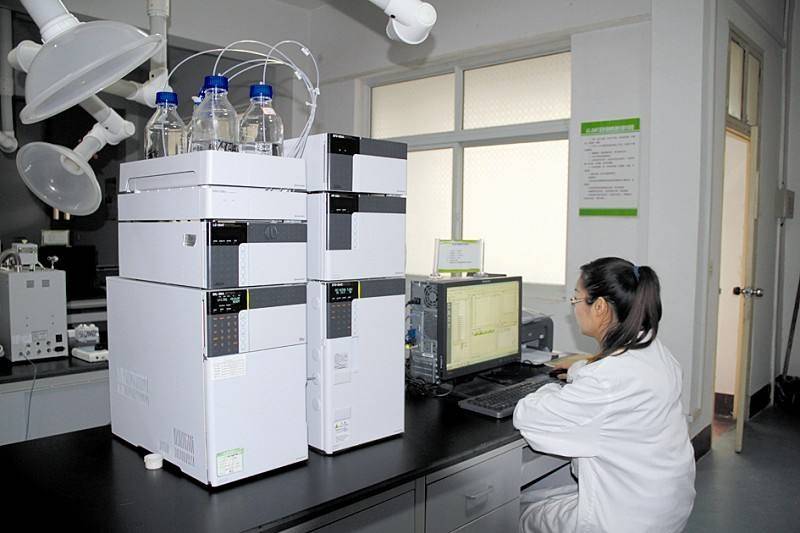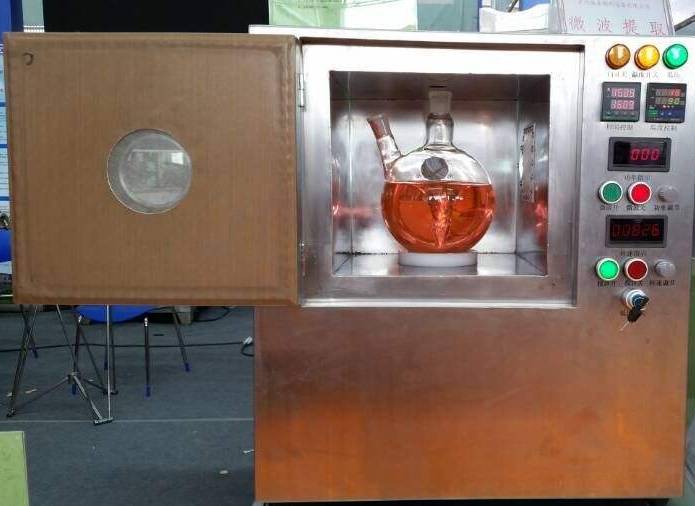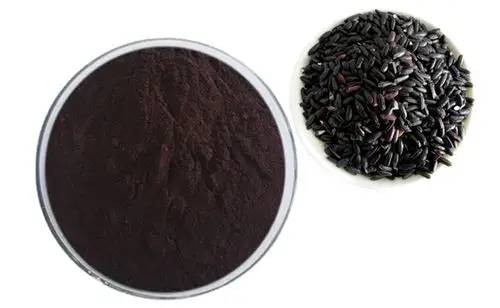黒米エキスの成分は何ですか?
Black rice is a special type of rice that is rich in nutrients, including various trace elements and anthocyanins. According to the Compendium of Materia Medica, black rice has the effects of nourishing the yin and the kidneys, strengthening the spleen and warming the liver, improving eyesight and promoting blood circulation. In folk culture, black rice has the reputation of being a “precious tribute rice” and “medicine rice” [1]. Modern research has proven that black rice has various biological activities such as anti-oxidation, anti-inflammation, and prevention of cardiovascular and cerebrovascular diseases [2].
これらの生物学的機能は、黒米に含まれる色素成分と密接に関連しています。一方で、健康への関心が高まるにつれ、人がよく食べる黒米やその中の色素にも注目が集まっています。黒米エキスの成分同定、抽出過程、分離精製、安定性などに関する研究が増えている。だから、本稿评论研究成分分析、抽出・浄化作業分離、に対して黒米と安定の色素の完全な理解を得るための属性玄米顔料や深加工などの発展を推進して玄米分野の食品や健康食です。
1黒米エキスの成分の分離・同定・決定方法
1.1黒米エキスの成分の分離と同定
主な構成要素玄米抽出はアントシアニン。アントシアニンは熱や光などの条件に不安定であるため、分離や同定が困難になります。現在、黒米エキス成分の同定に最も広く使用されている方法は、液体クロマトグラフィー-タンデム質量分析法である。
今回、sun wujuanたちは、赤外分光法と高性能液体クロマトグラフィータンデム質量分析法を用いて、黒米エキスの超音波エキス中の色素成分を分離・同定した。分離された物質の一次および二次質量スペクトルから、抽出物にはシアニジン-3-グルコシドとピオニジン-3-グルコシドの2つのアントシアニン成分が含まれており、質量比はそれぞれ15.20%および39.60%であることが判明した[3]。朴容疑者らは玄米エキス)が使用される研究対象にして使用高性能液体クロマトグラフ顔料の成分を識別するために紫外線可視観察しして構成要素に対して黒米、cyanidin-3-glucoside、anthocyanin-3-glucoside、malvinidin-3-glucoside、geraniol-3-glucoside delphinidin-3-glucoside、なかでもcentaureidin-3-glucosideの内容は高く、コンテンツの[4]の相対的によって95%を占めた。
mikihlemoriたちは、高性能液体クロマトグラフィー-フォトダイオードアレイ検出法とエレクトロスプレー質量分析法を用いて黒米の色素成分を同定し、主成分がシアニジン-3-グルコシドで、相対含有量がそれぞれ91.13%と4.74%であることを証明した[5]。zhang mingweiらは、黒米から4種類のアントシアニン(マルビン、ペラルゴニジン3,5-ジグルコシド、シアニジン3-グルコシド、シアニジン3,5-ジグルコシド)を単離、精製、同定した。そのうち、ゼラニウム-3,5-ジグルコシドおよびトウモロコシの花-3,5-ジグルコシドは、前世代では同定されていない成分である[6]。

要約すると、黒米の色素組成は、アントシアニン成分の多様性から構成されている。研究者によって特定された成分は、トウモロコシの花-3-グルコシドであり、これも最も高い含有量を持つ成分である。
1.2黒米エキスの測定方法
Currently, the main methods for determining black rice extract include spectrophotometry, high-performance liquid chromatography, and liquid chromatography-mass spectrometry tandem methods. The advantage of the liquid chromatography-mass spectrometry tandem method is in separation and identification, with many advantages such as high efficiency, speed, and sensitivity. However, the equipment used in this method is more expensive, and the technical requirements for operation and maintenance are higher. Liquid chromatography and spectrophotometry are more suitable for ordinary enterprises and other institutions.
ying longbinたちは、シアニジン-3-グルコシドを標準物質として、高性能液体クロマトグラフィーを用いて黒米中のアントシアニン物質を検出する方法を確立した。検出波長は275 nmとし、移動相はメタノールと水(ギ酸1%含有)を勾配で溶出させた。この方法は、アントシアニンの質量濃度0.0052 ~ 0.052 mg/ mlの範囲で良好な直線性(r =0.9998)を示し、平均回復率99.72%、rsd 0.9100、最小検出限界0.1 ng/ mlである[7]。
As early as 1982, Osawa used the pH difference method to determine the anthocyanin content in food. Using cyanidin-3-glucoside as the reference substance, he established a method for determining anthocyanin using the fact that the structural transformation of anthocyanin components under different pH conditions is a function of pH, and the absorbance values are different at the same wavelength [8]. Zhou Shukun et al. used this method to determine the pigment content of black rice. Using cyanidin-3-glucoside as the reference substance, they measured the maximum absorbance of black rice extract solutions at pH 1.0 and 4.5, and calculated the pigment concentration of black rice based on the molecular weight and extinction coefficient of cyanidin-3-glucoside[9]。
黒米抽出物の抽出および精製プロセスにおいて、研究者はシンプルで迅速な測定方法を好む。zhang yinliang、guo mei、wu supingらは分光光度計を用いて、黒米色素の抽出速度を測定した。試料抽出物を適切に希釈した後、最大吸収波長で吸光度を測定し、吸光度値を用いて抽出・精製結果を評価した[10-12]。
2黒米エキスの安定性
アントシアニン成分の安定性は、光、温度、酸化剤などの要因に影響されやすい。アントシアニンは温度に敏感であり、長時間加熱すると無色のカルコノン構造を形成して退色する。アントシアニンは、強い光を照射することで基底状態から励起状態に変換することができるため、分解反応が起こりやすくなります[13]。現在、黒米エキスの成分はアントシアニン成分として同定されている。そこで、アントシアニンの光や熱などの条件下での安定性を調べ、黒米色素の貯蔵・塗布条件を明らかにしました。
2.1黒米エキスの安定性に対する熱と光の影響
Jiang Xinlong used isolated and purified black rice pigment extract as the object of study, and proved that the thermal and photodegradation of black rice anthocyanin both conformed to the first-order reaction kinetic equation [13]. Ji Yunqi et al. heated black rice pigment solutions to 70 °C and 100 °C, respectively, for 30 minutes, and found that the absorbance at 510 nm decreased by 7.2% and 20%, respectively [14]. This proves that the higher the temperature and the longer the heating time, the faster the thermal degradation of black rice anthocyanin. Black rice anthocyanin was placed under constant temperature conditions of 24°C and a pH of 3.0, and then exposed to natural indoor light (average light intensity 10001x), strong sunlight (average light intensity 450001x), and dark conditions for 10 days. The degradation rates were 0.01184/h, 0.01639/h and 0.0035/h, with half-lives of 58.54, 42.29 and 197.80 h, respectively [13]. It can be seen that black rice pigment is relatively poor in heat and light resistance, and that low temperatures and dark conditions are conducive to its preservation.
2.2超音波場が黒米エキスの安定性に与える影響
zhou shukunらは、黒米エキスの安定性に対する超音波の影響を調べた。黒米顔料の劣化に対する初期濃度,ph,超音波周波数,超音波出力,反応温度の影響を調べた。反応速度論的解析により、超音波および非超音波環境における黒米顔料の化学反応は、いずれも一次反応則に適合していました。超音波場での活性化エネルギーは37697.94 kj /mol,前指数係数は3800.55 s-1であった。非超音波環境では、活性化エネルギーは39531.41 kj /mol、プレファクターは2887.07 s-1である。比較すると、超音波は活性化エネルギーを減少させ、有効な分子衝突の数を増加させ、劣化反応が起こりやすくなることが示されています。超音波場における黒米色素の有効分子衝突数が増加し、活性化エネルギーが減少し、反応が起こりやすくなることがわかります[9]。

2.3顔料の安定性に対する酸性とアルカリ性の影響
Black rice extract shows different colors in different acid-base solutions, and its stability is also different, which is consistent with the nature of anthocyanins. When the pH of the black rice pigment solution is < 4, the pigment is red; when the pH of the black rice pigment solution is 5 to 7, the black rice pigment is purple. Zeng Huiqin and others have demonstrated that under acidic conditions and at a temperature of 40°C, black rice pigment is stable to vitamin C, low concentrations of preservatives and different metal ions Na1+, Mg2+, Ca2+, and Zn2+. Under alkaline conditions, relatively long periods of high temperatures, oxidants such as H2O2, metal Fe3+ ions, high concentrations of benzoic acid, and ultraviolet light all affect the stability of black rice pigment [15].
2.4金属イオンに影響を与える要因
milaらの研究では、金属イオンが黒米の色素に選択的に色を強める効果があることが示されている。zn2 +またはmg2 +が溶液中に存在するとき、溶液は赤色である。fe2 +が存在する場合、溶液は黒がかった紫色になります。ca2 +が存在する場合、溶液は黒っぽい赤です;al3 +が存在する場合、溶液は紫色になる。金属イオンの顔料への色向上効果は、イオンの加水分解と顔料と金属イオンのキレート化に関連しています。メカニズムは、さらに調査する必要があります。
3黒米エキスの抽出・精製技術
3.1溶剤抽出
溶媒抽出技術は、最も広く使用されている天然物抽出技術の1つです。この方法は、原料中の目的成分の化学的性質とlikeがlikeを溶解する原理に基づいて、主に適切な抽出溶媒を選択し、目的以外の成分の溶解を可能な限り回避します。一般的に使用される抽出方法には、マセレーション、煎じ薬、逆流が含まれます。黒米エキスの抽出はマセレーションにより行われ、抽出溶媒には適切なphのエタノール溶液が用いられることが多い。wu supingらはエタノールを溶媒として使用し、マセレーション法による黒米アントシアニンの抽出に寄与した。抽出条件は、エタノール50%、粉砕度50メッシュ、液対材料比1:5、浸漬時間30分、浸漬温度80°c、ph 3[12]であった。guo meiたちは、エタノールを溶媒として用い、この抽出法を用いて黒米アントシアニンを抽出した。単因子実験と直交実験を通じて、黒米色素の抽出率に影響を与える主な要因を決定した:抽出時間>液体対材料比>抽出时温度>抽出ph .最適な抽出プロセス条件は、95%エタノール、液体と材料の比1:45 (g: ml)、抽出ph 3.0、抽出温度80°c、抽出時間90分であった[11]。
3.2超音波抽出
超音波抽出技術は、超音波の「キャビテーション効果」、機械的効果、熱効果を利用して、有効成分の拡散と放出を加速し、目的の成分を抽出する。この方法は、フラボノイド、ポリフェノール、その他の有効成分などの様々な天然物の抽出に適用されています。この方法は抽出温度が低く、効率が高く、時間が短いという利点がある。
Zhang Jixiang et al. used an ultrasound-assisted extraction method to extract anthocyanin from black rice. The optimal process conditions were determined: ethanol concentration 80%, ultrasound time 50 min, liquid-to-material ratio 1:32, ultrasound power 250 W, and the optimal extraction rate was 4.5%. This is nearly three times higher than the extraction rate of the traditional Soxhlet extraction method [17]. Zhang Zhihui et al. used ultrasound to assist in the extraction of anthocyanin from black rice. The optimal conditions were determined using the anthocyanin content, DPPH free radical scavenging rate, and total antioxidant capacity as evaluation indicators: ultrasonic power 280W, extraction time 20min, ethanol concentration 70%, solid-liquid ratio (mg/mL) 1:20, temperature 50℃, under these conditions the anthocyanin extraction rate was 12.56mg/g, DPPH free radical scavenging rate was 54.41%, and TAC was 52.38 u/mL [18].
3.3マイクロ波抽出法
マイクロ波抽出技術は、マイクロ波放射のエネルギーを使用して抽出溶媒を加熱し、ターゲット成分を拡散させてサンプルから溶媒に溶解させます。この方法は均一加熱、良好な選択性、溶媒保存性、簡単な操作性、良好な再現性、省エネルギー、環境保護などの利点がある。近年、マイクロ波抽出技術は、天然物から有効成分を抽出するために広く使用されており、一定の利点を示しています。
ma pingたちは、マイクロ波を利用した黒米エキス抽出プロセスを最適化した。2段階直交計画法を用いた実験では、エタノール濃度と液/物質比が抽出速度に有意な影響を与えることが示された。
抽出条件はエタノール濃度80%、液-物質比1:18 (m: v)、マイクロ波抽出時間94秒、黒米アントシアニン収率4.97%であった[19]。wang huiは、アントシアニン抽出物の吸収度を評価指標とし、マイクロ波による黒米色素成分の抽出を研究した。その結果、実験範囲内では、マイクロ波出力、液/物質比、エタノール濃度が、黒米アントシアニン抽出物の吸光度に強い影響を与えることがわかった。マイクロ波の作用時間は黒米のアントシアニン抽出物の吸光度に弱い影響を与え,黒米のアントシアニン抽出速度はマイクロ波の出力,液-物質比,エタノール濃度と正の相関を示した[20]。
3.4加水分解酵素
Enzymatic hydrolysis makes use of the properties of enzymes. The right enzyme can be selected to break down plant tissue under relatively mild conditions. Cellulase is often used to extract the active ingredients of natural products because it can break down plant cell walls and promote the dissolution of target components.
liu yongjiたちは、セルラーゼを用いて黒米ぬかからアントシアニンを抽出し、単因子実験と応答表面法によって抽出過程を最適化した。好適なプロセス条件が揃えられ:それ酵素加え2.0%量、タンパクプロダクトオブザ酵素387°Cの温度、タンパクプロダクトオブザ酵素128.8min時の素材で液体比で10分、抽出時間は約40分、表定抽出の温度が50°Cエタノール抽出濃度解決策は80%抽出率をこのような状況のなかで、黒い糠のアントシアニンは219人に達するかもしれmg / g(理论値値)[21]。
3.5黒米エキスの精製過程に関する研究
黒米エキスの精製技術として最も研究されているのは、高分子樹脂の分離精製技術と膜分離技術である。黒米の色素を精製するためのads-5、ads-7、ads-f8、ads-17、nka-9、ab-8、s-8、d4020、nka 9種類のマクロ多孔質吸着樹脂を比較した。吸着能力と脱着能力を比較した結果、黒米アントシアニンの精製に適した樹脂であることがわかりました。溶出溶媒80%エタノール、サンプル負荷流量1.0 bv /h、脱着流量2.0 bv /h。アントシアニン含有量は22.59%で、粗抽出物のアントシアニン含有量(3.448%)よりも高い[22]。ハンホらは膜分離技術を利用して、黒米のアントシアニンを精製した。
まず、黒米エキスから脂溶性成分を除去するために分子量1000 kdのセラミック膜を用い、その後、脱脂エキスを濃縮するために100 d螺旋巻きナノろ過膜を用いた。玄米を集中的アントシアニンの膜分離・浄化と=干物コンテンツで得られた、今回の集中膜も分離浄化は646 g / 100 mL乾燥の物質はコンテンツで得られた、今回の集中伝統蒸発テクノロジーが鍵656 g / 100 mLです色価値が2.71%・193、それぞれ脂肪が多ければは0.30ウォン、g / 100 mL金利引き下げた。このように、膜分離精製技術は、黒米アントシアニンの純度と品質を向上させることができます。膜分離後は、色値の損失がなく、同時に脱脂と淡水化の効果があり、膜分離技術が黒米のアントシアニンの精製に利用できることを証明した[23]。
4 展望
中国玄米は米貴重な玄米抽出は自然食品添加物として使われることができる食品の原料、着色料、抗酸化、など多様な食料のhealth-beneficialや開発が饮み物やなどパン、これらは人々最長の食品に消費されるものですdeng wenhuiらは、黒米エキスの濃縮物を原料として、ショ糖、クエン酸などと組み合わせて、黒米色素飲料を開発した[24]。しかし、黒米のアントシアニン抽出物や精製物の応用や、色素抽出後の残留物の継続的な使用に関する研究は、現在のところほとんどありません。この2つの問題を解決できれば、黒米エキスの利用や黒米の加工のさらなる発展が期待される。
参照:
[1]閔俊。黒米の栄養特性[j]。2013年(平成25年)9月1日:国道41号が開通。
[2]耀で。黒米のアントシアニン成分がコレステロール吸収に及ぼす影響とそのメカニズムに関する研究[d]。2014年、華東科技大学教授。
[3] sun wujuan, jin lingxia, zhao caibin, et al。黒米色素の組成および構造解析のための高性能液体クロマトグラフィー-タンデム質量分析法[j]。^「physical and chemical inspection-chemical edition」。physical and chemical edition .(2012): 1023-1026.(英語)
[4] park y s, kim s j, chang h i .黒米(heugjinjubyeo)からのアントシアニンの単離とその抗酸化活性のスクリーニング[j]。日本微生物学会誌。2008,36(1):55-60。
[5] mikihlemori, eunmikoh, alysone m .黒米中のアントシアニンに対する料理の影響(oryza sativa l.japonica var.sbr) [j]。農業と食品化学。2009,57 (5): 1908-1914。
[6] zhang mingwei, guo baojiang, zhang ruifen, et al。黒米中の抗酸化活性成分の分離精製と構造同定[j]。中国農業科学,2006,39(1):153-160。
[7] ying longbin, yu sangang, liu cuiping, et al。高機能液体クロマトグラフィーによる黒米中のアントシアニン成分の定量[j]。日刊杭州师范大学(天然科学版)、2012年11(1):28勝32敗。
[8]大沢洋之食品の色としてのアントシアニン[m]。『新潮』学習研究社、1982年。85-85。
[9] zhou sk, cao yp, huang zh。超音波場における黒米顔料の安定性に関する研究[j]。中国食品添加物,2015(3):71-76。
[10] zhang yinliang, zhou wenquan, zheng jianqiang, et al。超音波を用いた黒米からのアントシアニン抽出とその抗酸化特性に関する研究[j]。鄭州軽工業大学紀要(自然科学編),2013,28(1):16-20。
【11】郭梅、史雲霞。アルコール可溶性法による黒米色素の抽出法に関する研究[j]。2015年食品研究開発、36(8):58-60。
[12]呉Suping。黒米色素の抽出と安定性に関する研究[j]。中国の調味料,2011,36(12):106-110。
[13]姜瞻化。黒米アントシアニンの分解特性に関する研究[j]。中国穀物油食品誌,2013,28(4):27-31。
[14] ji y q, xu c y, zhang s p .黒米色素の抽出プロセスと安定性の最適化に関する研究[j]。^『人事興信録』第2版、大正7年(1932年)、33-35頁。
[15] zeng h q, zhang y m, jin h .黒米顔料の安定性に関する研究[j]。食品研究開発、2014年、35(19):17 ~ 20人である。
[16] mi, l., xu, h ., li, j ., et al。黒米アントシアニンの抽出と安定性。^『仙台市史』第2巻、仙台市、2011年、32(2):263-265頁。
[17] zhang, j ., zhao, w ., bai, x ., et al。超音波を用いた黒米からの黒色素抽出法の最適化。^ a b c d e f g h i(2010年)、39-41頁。
【18】張志恵,余国平。超音波を用いた黒米からの抗酸化物質抽出[j]。食品産業科学技術,2001(12):338-342。
【19】馬平、郭喜娟、郭増旺。マイクロ波による黒米からのメラニン抽出プロセスの最適化[j]。食品・機械など、2014年、30(5):229-231人である。
暉】[20]王ランクイン。黒米からのメラニン抽出のマイクロ波支援の影響要因に関する研究[j]。1979年(昭和54年)- 1979年(昭和54年)。
[21] liu yongji, liu guoling, huang qiandi, et al。セルラーゼによる黒米からのアントシアニン抽出の応答表面法による最適化に関する研究[j]。2014年食品研究開発、35(10日):"となった。
【22】侯zhaohua, zhai huqu, wan jianmin。黒米アントシアニンの抽出と精製[j]。2010, 31(10): 53-59。
[23] han hao, li xinsheng, zhang zhijian, et al。黒米アントシアニン色素の脱脂・濃度に対する膜技術の応用[j]。2012年食物科学専攻、33(6):297-300。
[24] deng wenhui, li xinsheng, wu sanqiao, et al。黒米の色素精製とスポーツドリンク配合に関する研究[j]。食品科学技術,2013,38(6):109-113。


 英語
英語 フランス
フランス スペイン
スペイン ロシア
ロシア 韓国
韓国 日本
日本




